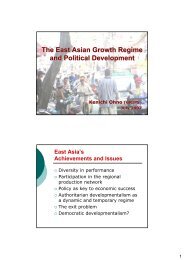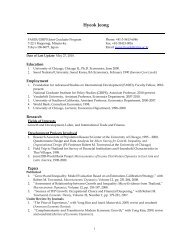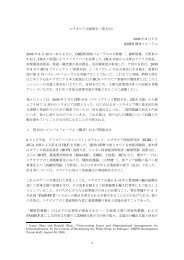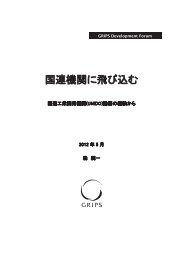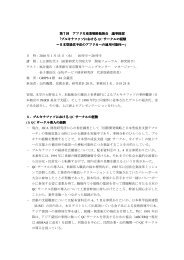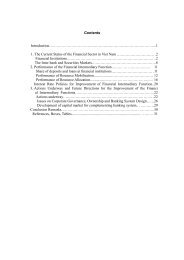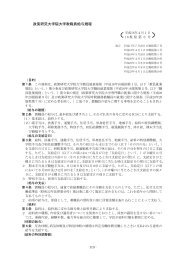Evidence from Firm-level Data in Vietnam
Evidence from Firm-level Data in Vietnam
Evidence from Firm-level Data in Vietnam
You also want an ePaper? Increase the reach of your titles
YUMPU automatically turns print PDFs into web optimized ePapers that Google loves.
an important factor that guides firms to sell to foreign markets, as compared to other observed and unobservedfactors. For example, it is possible that ow<strong>in</strong>g to forward-look<strong>in</strong>g managerial strategy or other unobservedfirm-specific factors, certa<strong>in</strong> firm-specific observable advantages such as size, age or skilled labor sources, oreven to some positive exogenous shock, some firms can become exporter regardless of their TFPdisadvantage. Furthermore, because of the high persistence <strong>in</strong> export<strong>in</strong>g status, this firm may cont<strong>in</strong>ueexport<strong>in</strong>g. If there are considerable numbers of firms with low TFP that can export <strong>in</strong> that way, our estimate ofproductivity effect is more likely to be <strong>in</strong>significant. If it is the case, the learn<strong>in</strong>g-by-export<strong>in</strong>g may be a gooddeterm<strong>in</strong>ant for the superiority of exporters that we f<strong>in</strong>d at the beg<strong>in</strong>n<strong>in</strong>g of this section. Another possibleexplanation for the f<strong>in</strong>d<strong>in</strong>g of the <strong>in</strong>significance <strong>in</strong> TFP effect is that TFP is actually important but themagnitude of the importance varies across foreign markets or across commodities, even across commoditieswith<strong>in</strong> a narrowly-def<strong>in</strong>ed <strong>in</strong>dustry. Therefore, when we estimate the coefficient for TFP variable withoutcontroll<strong>in</strong>g for the heterogeneity among foreign markets or commodities, the effect of TFP may be rendered<strong>in</strong>significant. Damijan et al. (2004) do exam<strong>in</strong>e this matter. They f<strong>in</strong>d <strong>in</strong> the case of Slovenian firms that whileit is obvious that higher productivity <strong>level</strong> is required to start export<strong>in</strong>g to advanced countries, this is not thecase for firms that start export<strong>in</strong>g to less-developed countries. They also f<strong>in</strong>d that different foreign marketsrequire different entry costs. The heterogeneous entry costs also generate a positive relationship between thenumber of foreign markets served by firms and their productivity <strong>level</strong>s. If this is the case, <strong>in</strong> order for ourmodel to be more relevant <strong>in</strong> f<strong>in</strong>d<strong>in</strong>g the effect of productivity, we need more <strong>in</strong>formation about firms’export<strong>in</strong>g markets and products. However, this <strong>in</strong>formation is not available <strong>in</strong> the data we use, h<strong>in</strong>der<strong>in</strong>g us<strong>from</strong> exam<strong>in</strong><strong>in</strong>g this possibility.VI. CONCLUDING REMARKSThis paper contributes an empirical analysis to the exam<strong>in</strong>ation of the role of sunk cost and heterogeneouscharacteristics of firms <strong>in</strong> the explanation of behavioral difference among firms <strong>in</strong> their export<strong>in</strong>g decisions.Given the panel of firm-<strong>level</strong> data, appropriate microeconometric methods are made possible for use to testfor determ<strong>in</strong>ants of firms’ export behaviors <strong>in</strong> the dynamic format that properly controls for unobserved firmeffects and simultaneity, two important hurdles usually seen <strong>in</strong> the related literature. Therefore, the estimationresults are expected to give more accurate <strong>in</strong>terpretation of the real situation <strong>in</strong> <strong>Vietnam</strong>.Most of the ma<strong>in</strong> f<strong>in</strong>d<strong>in</strong>gs <strong>in</strong> this paper are <strong>in</strong> l<strong>in</strong>e with theoretical prediction or empirical f<strong>in</strong>d<strong>in</strong>gs <strong>in</strong>other countries, such as the superiority of exporters over non-exporters <strong>in</strong> a range of characteristics <strong>in</strong>clud<strong>in</strong>gtotal factor productivity, firm size, firm age, or labor skill; the persistence of export status due to sunk entrycosts; or the important role of firm size, firm age or foreign ownership <strong>in</strong> predict<strong>in</strong>g the probability ofexport<strong>in</strong>g of firms. Besides, the paper also provides proper empirical firm-<strong>level</strong> evidence about exportdecision determ<strong>in</strong>ants that are idiosyncratic to a develop<strong>in</strong>g country under a fast track of reform like <strong>Vietnam</strong>.<strong>Firm</strong>s that use labor-<strong>in</strong>tensive technology, employ more skilled labors, or offer competitive labor service aremore likely to be <strong>in</strong>volved <strong>in</strong> serv<strong>in</strong>g foreign markets; and such labor-<strong>in</strong>tensive and skill-<strong>in</strong>tensive <strong>in</strong>dustriesas garments, textiles, leather products, wood and wood products, and foods and beverages seem possesscomparative advantage <strong>in</strong> the world market. The <strong>in</strong>significant effect of total factor productivity may alsoreflect the real situation of <strong>Vietnam</strong> as a country <strong>in</strong> reform with unstable and diversified structure of exportmarkets and commodities. Besides, higher probability of export<strong>in</strong>g for firms <strong>in</strong> the year 2004 as compared tothat <strong>in</strong> 2003 can also be <strong>in</strong>terpreted as a general improvement <strong>in</strong> the country’s economy <strong>in</strong> its process of23



